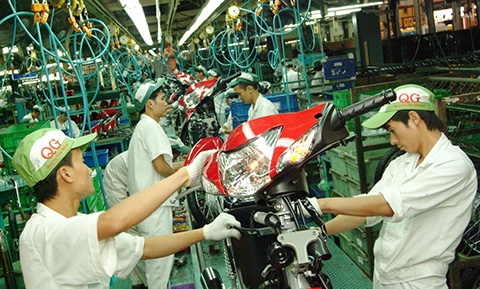Fixes key to boosting FDI

illustration photo
That advice for Vietnam was highlighted in the Asian Development Bank’s (ADB) Asian Development Outlook 2013 report released last week.
Tomoyuki Kimura, ADB country director for Vietnam, said Vietnam continued to grapple with banking sector problems, which were eroding foreign investors’ confidence.
Banks reported in October 2012 that non-performing loans (NPLs) were about 4.8 per cent of the total loans. However, based on closer surveillance of the banking system, the State Bank estimated that the ratio of bad debts was 8.8 per cent at mid-year. It trimmed that estimate to 6 per cent in February 2013.
But, the report noted: “Independent analysts estimate that NPLs could be in double digits using international accounting standards. NPLs have proliferated due to rapid growth in lending over several years followed by the squeeze on credit in 2011, the downturn in the economy and property market, and poor performances by some highly leveraged state-owned enterprises (SOEs).”
Kimura cited key issues: “One of the major obstructions for Vietnam to coax more foreign direct investment (FDI) is the snail-paced reformation of SOEs. We have many times raised this issue, but equitisation has continued slowing in the recent years. One goal is to divest SOEs’ noncore businesses by 2015, as many SOEs have accrued debts by investing in areas unrelated to their core businesses.”
The National Steering Committee for Enterprise Renovation and Development reported that Vietnam’s nine state-owned groups and corporations’ total debt within 2012 mounted to over $64.18 billion, equivalent to 47 per cent of Vietnam’s gross domestic product (GDP) last year. Meanwhile, their total profits last year reached VND127.51 trillion ($6.13 billion) only, down 5 per cent on-year.
“Ineffective SOEs have distorted the Vietnamese government’s allocation of resources and further affected effective enterprises. They prevent foreign investors from investing more in Vietnam,” Kimura said.
Last year saw 21 large SOEs restructured. Vietnam currently has nine state-run economic groups and 94 state-owned corporations which have yet to be streamlined. Restructuring plans have been approved for 24 large SOEs.
“A more open economy means all companies can compete equally without any state intervention in companies’ performance. Foreign enterprises are waiting for the Vietnamese government to open the door of its economy wider,” said ADB’s country economist Dominic Mellor.
He said as ASEAN integration in 2015 approached, the country faced increased competition for FDI from Indonesia, Myanmar, Thailand and the Philippines, which are offering attractive investment incentives. For example, as for projects in economic zones, Vietnam offers corporate income tax (CIT) exemption for four years and 50 per cent reduction of payable tax amounts for nine subsequent years.
But in Thailand, CIT exemption lasts up to eight years plus a 15 per cent CIT incentive for another five years. Besides, Thailand also offers double deduction of transportation, power and water supply costs for investors, and an additional 25 per cent deduction of infrastructure construction and installation costs.
In the Philippines, the CIT exemption lasts six years, with free import tax for raw materials, capital equipment, machineries and spare parts, and exemption from payment of any and all local government imposts, fees, licences or taxes.
ADB cited Vietnam’s ranking in the World Economic Forum’s Global Competitiveness Index falling by 16 places in the past two years to 75th of 144 countries. That puts it below other larger Southeast Asian economies. Vietnam scored poorly on several index components, including infrastructure (95), business sophistication (100), respect for property rights (113), irregular payments and bribes (118), and soundness of banks (125).
The ADB report also put Vietnam’s GDP growth in 2013 at 5.2 per cent, down from the 5.7 per cent the bank previously forecast, then picking up to 5.6 per cent in 2014 if progress is made in strengthening the banking sector and recovery in major industrial economies gathers momentum in 2014.
Meanwhile, inflation is seen easing to 7.5 per cent on average this year before quickening to 8.2 per cent in 2014. This view assumes reasonable weather for food production, a broadly stable dong exchange rate, and restrained policy stimulation. The trade surplus is expected to climb to a record $12.5 billion in 2013 and the current account surplus to increase further this year before easing in 2014 as imports accelerate in tandem with GDP growth.
What the stars mean:
★ Poor ★ ★ Promising ★★★ Good ★★★★ Very good ★★★★★ Exceptional
Latest News
More News
- Stress laid on high-quality FDI inflows (December 15, 2025 | 11:00)
- Can Tho utilises its growth advantages (December 15, 2025 | 09:09)
- Ca Mau unlocking potential to shape a more sustainable future (December 15, 2025 | 09:02)
- Major projects to be inaugurated nationwide (December 15, 2025 | 08:00)
- MoF workshop highlights mounting concerns over ODA on-lending costs (December 12, 2025 | 16:05)
- National Assembly approves pilot mechanisms to accelerate major projects in Hanoi (December 12, 2025 | 11:29)
- Legislation gives government flexibility for loan guarantees (December 11, 2025 | 18:04)
- Vietnam eases policy approval requirements, simplifies foreign and outbound investments (December 11, 2025 | 17:53)
- Vietnam masters core technologies of automobile value chain (December 11, 2025 | 17:46)
- VAL opens second line of largest soybean crushing complex in Southeast Asia (December 11, 2025 | 12:08)


















 Mobile Version
Mobile Version